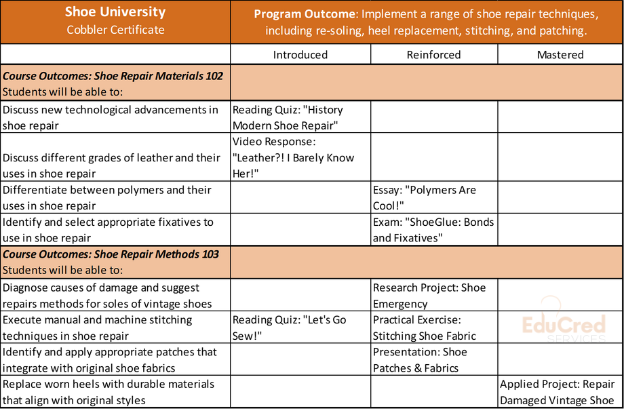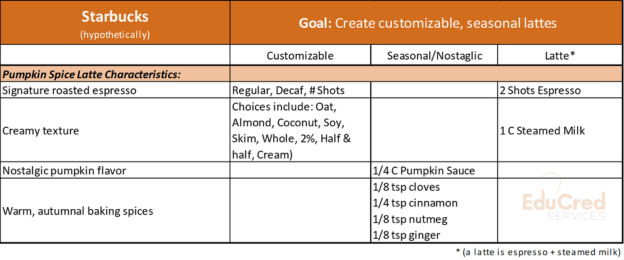Curriculum Maps Explained (with examples)
It took discipline, but I waited until October to write a blog about Pumpkin Spice Lattes (you’re welcome). It’s become an annual tradition for someone on our team to write a post about how the much-hyped coffee harbinger of autumn is analogous to some aspect of higher education—and this year is no exception. Lewis Carrol’s Mad Hatter once famously asked, “Why is a raven like a writing desk?” As someone who aspires to that spirit of chaotic inquiry (and as a lover of a good non sequitur), I now ask you this: “How is a Pumpkin Spice Latte recipe like a Curriculum Map?”
For those of you non-higher ed folks, a curriculum map is a development tool that visually connects course content and assessments to program outcomes. This means that if a school claims that “Graduates can design effective footwear using sustainable materials,” the school can actually trace that outcome back to specific course content, assignments, and assessments about recycled and renewable materials and shoe design concepts. In other words, it’s one of the ways schools develop a cohesive curriculum that results in observable and measurable learning. And, when necessary, it’s a way they can show that they’re doing what they said they would do.
We’ve discussed this in a previous blog, but one of the defining characteristics of a PSL is that it is from Starbucks. Their version is the version, and it is the same every time. Full disclosure: I probably only order a PSL twice a year, but when I do, I never worry about my drink being made without the pumpkin flavoring, or if the barista will randomly decide to use decaf coffee, or if this time it might be iced for no reason. That’s because Starbucks uses a recipe that follows a prescribed process with precise measurements. A PSL is the same everywhere. The one you order one from the barista at your neighborhood Starbucks at 5:00 am will be the same as the one you order from another barista at 9:30 pm at the Starbucks in the Chicago O’Hare airport.
A curriculum map is your school’s PSL recipe. It’s how you make sure that students are learning what they’re supposed to in your courses/programs.
Let’s say that Shoe University (Shoe-U) offers a Cobbler Certificate program that says, “Graduates will apply various shoe repair techniques, including re-soling, heel replacement, stitching, and patching.” That’s such a great outcome (it’s clear and measurable)! What aspiring cobbler wouldn’t want to enroll at Shoe-U? But, what if our cobbler-to-be applies, enrolls, and goes through the program, but every single course is about 17th-century French fashion? They might have learned a lot; they might even have learned a lot about shoes, but will they be able to apply various shoe repair techniques? No. Will their Cobbler Certificate allow them to be successful in the profession? No. Will their educational investment help them pursue their cobbling dreams? Again, no.
So how do we avoid “certified” cobblers who can’t actually cobble? The same way Starbucks avoids handing a paper cup full of cold milk and cinnamon sticks to customers who ordered a Pumpkin Spice Latte—build a recipe; build a curriculum map.
So, let’s help Shoe-U get it right. They know from conducting industry research and talking to experts that in order for their graduates to succeed in their field, they actually do need to be able to “apply various shoe repair techniques, including re-soling, heel replacement, stitching, and patching.” So, Shoe-U wants to keep this program outcome. Now, they need to use a curriculum map to align their courses and identify how they plan to assess student acquisition of these skills. To ensure that students learn the theory, techniques, and applications of shoe repair, Shoe-U’s faculty determine that two courses are needed: one on shoe repair materials, and one on shoe repair methods. A simplified version of this curriculum map might look like this:
Shoe-U can see comprehensively what their students will learn throughout their program and where they will be assessed on each course and program outcome. Now Shoe-U can document exactly how upon completion, students will have achieved the program outcomes.
It may not look like a recipe, but that’s essentially what a curriculum map is. Don’t believe me? I came prepared. What if we took our beloved PSL and wrote it like this?
It’s still a recipe, but this format shows us how Starbucks could have (hypothetically) started with the overarching goal of creating seasonal lattes and ended with the delicious individual components of the PSL. (Try this recipe at your own peril, these measurements were made up purely for this example.)
If you’ve made it to the end of this blog, you may be thinking to yourself, “okay, great, curriculum maps are like recipes—what’s your point?” Oh, dear hypothetical reader, my point is three-fold:
Pumpkin spice lattes are delightfully consistent and generally free of unwanted surprises.
A curriculum map is an education recipe for a program (which should also be delightfully consistent and generally free of unwanted surprises).
A pumpkin spice latte recipe is like a curriculum map because both ensure that the end product contains what it should, be it knowledge or nutmeg.



